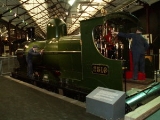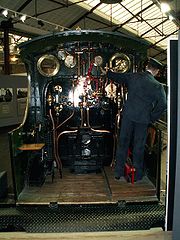
GWR 2301 Class
Encyclopedia
The Great Western Railway
(GWR) 2301 Class or Dean Goods Class is a class of British 0-6-0
steam locomotive
s.
Swindon railway works built 260 of these goods locomotives between 1883 and 1899 to a design of William Dean. The 2301 class broke with previous GWR tradition in having inside frames only and changes were made in the boiler design during the period that they were being built. The first twenty engines were originally domeless though all were provided with domed boilers in due course. They were numbered 2301–2360 and 2381–2580 (2361–2380 were of the 2361 class
, which were similar visually but had outside frames).
and sent to France. 46 of these engines returned to England in the early summer of 1919, but the other 16 had been sent on to Salonika at the beginning of 1918. Two of these engines, nos 2308 and 2542, were sold to the Ottoman (Aiden) Railways and renumbered 110 and 111. No 111 was withdrawn in September 1929, but 110 lasted until the 1950s. Of the 14 engines remaining at Salonika, six were written-off and the other eight returned to England in April 1921.
At the outbreak of the Second World War, the War Department
requisitioned 100 of these engines from the GWR and the GWR had to hastily reinstate some engines that had been recently withdrawn. The requisitioned engines were fitted with Westinghouse brakes and 10 were fitted with pannier tanks and condensing gear. All were painted black with their WD numbers painted on. In December 1940, the War Department requisitioned a further 8 engines.
At the time of the German invasion of France, 79 of these engines had been shipped to France. Some of the engines were destroyed in the retreat to Dunkirk whilst the remainder were used on the French railways by the German occupation forces. After the war, between 22 and 26 engines were sent to China under UNRRA auspices, and 30 were returned to the UK, but were deemed unfit for service and scrapped. No.2435 (WD no.188) was used in Silesia and then Austria until 1948 when it was claimed by the Russians before being handed back to the Austrians in 1952. Two further engines, nos 2419 and 2526 (WD nos 106 and 132) are known to have passed beyond the Iron Curtain. The remaining engines are assumed to have been scrapped.
Of the engines that remained in England, most of them worked at War Department and Ordnance depots around the country, though in 1943, 6 were shipped to Tunisia and thence to Italy.
s. They were progressively replaced by new BR standard class 2 2-6-0
engines, and no 2538 was the last to be withdrawn in May 1957.
 One locomotive, no. 2516 (built 1897), survived into preservation. It is currently a static exhibit at Swindon Steam Railway Museum
One locomotive, no. 2516 (built 1897), survived into preservation. It is currently a static exhibit at Swindon Steam Railway Museum
, although the tender is not on display: visitors consequently have a clear view into the driving cab (see pictures). The tender is displayed at STEAM.
Great Western Railway
The Great Western Railway was a British railway company that linked London with the south-west and west of England and most of Wales. It was founded in 1833, received its enabling Act of Parliament in 1835 and ran its first trains in 1838...
(GWR) 2301 Class or Dean Goods Class is a class of British 0-6-0
0-6-0
Under the Whyte notation for the classification of steam locomotives, 0-6-0 represents the wheel arrangement of no leading wheels, six powered and coupled driving wheels on three axles, and no trailing wheels...
steam locomotive
Steam locomotive
A steam locomotive is a railway locomotive that produces its power through a steam engine. These locomotives are fueled by burning some combustible material, usually coal, wood or oil, to produce steam in a boiler, which drives the steam engine...
s.
Swindon railway works built 260 of these goods locomotives between 1883 and 1899 to a design of William Dean. The 2301 class broke with previous GWR tradition in having inside frames only and changes were made in the boiler design during the period that they were being built. The first twenty engines were originally domeless though all were provided with domed boilers in due course. They were numbered 2301–2360 and 2381–2580 (2361–2380 were of the 2361 class
GWR 2361 Class
The 2361 Class is a class of steam locomotives of the Great Western Railway.It is sometimes described, erroneously, as the "outside-framed version of the Dean Goods"...
, which were similar visually but had outside frames).
War Service
In 1917, 62 engines were taken over by the Railway Operating DivisionRailway Operating Division
The Railway Operating Division was a division of the Royal Engineers formed in 1915 to operate railways in the many theatres of the First World War...
and sent to France. 46 of these engines returned to England in the early summer of 1919, but the other 16 had been sent on to Salonika at the beginning of 1918. Two of these engines, nos 2308 and 2542, were sold to the Ottoman (Aiden) Railways and renumbered 110 and 111. No 111 was withdrawn in September 1929, but 110 lasted until the 1950s. Of the 14 engines remaining at Salonika, six were written-off and the other eight returned to England in April 1921.
At the outbreak of the Second World War, the War Department
War Department (UK)
The War Department was the United Kingdom government department responsible for the supply of equipment to the armed forces of the United Kingdom and the pursuance of military activity. In 1857 it became the War Office...
requisitioned 100 of these engines from the GWR and the GWR had to hastily reinstate some engines that had been recently withdrawn. The requisitioned engines were fitted with Westinghouse brakes and 10 were fitted with pannier tanks and condensing gear. All were painted black with their WD numbers painted on. In December 1940, the War Department requisitioned a further 8 engines.
At the time of the German invasion of France, 79 of these engines had been shipped to France. Some of the engines were destroyed in the retreat to Dunkirk whilst the remainder were used on the French railways by the German occupation forces. After the war, between 22 and 26 engines were sent to China under UNRRA auspices, and 30 were returned to the UK, but were deemed unfit for service and scrapped. No.2435 (WD no.188) was used in Silesia and then Austria until 1948 when it was claimed by the Russians before being handed back to the Austrians in 1952. Two further engines, nos 2419 and 2526 (WD nos 106 and 132) are known to have passed beyond the Iron Curtain. The remaining engines are assumed to have been scrapped.
Of the engines that remained in England, most of them worked at War Department and Ordnance depots around the country, though in 1943, 6 were shipped to Tunisia and thence to Italy.
British Railways
Fifty-four locomotives passed to British Railways in 1948, mostly being used on Welsh branch lines due to their light axle loadAxle load
The axle load of a wheeled vehicle is the total weight felt by the roadway for all wheels connected to a given axle. Viewed another way, it is the fraction of total vehicle weight resting on a given axle...
s. They were progressively replaced by new BR standard class 2 2-6-0
BR standard class 2 2-6-0
The BR Standard Class 2 2-6-0 is a class of steam locomotive, one of the British Railways Standard classes of the 1950s. They were physically the smallest of the Standard classes; 65 were built....
engines, and no 2538 was the last to be withdrawn in May 1957.
Preservation

Swindon Steam Railway Museum
STEAM – Museum of the Great Western Railway, also known as Swindon Steam Railway Museum, is located at the site of the old railway works in Swindon, England – Wiltshire's 'railway town'...
, although the tender is not on display: visitors consequently have a clear view into the driving cab (see pictures). The tender is displayed at STEAM.

